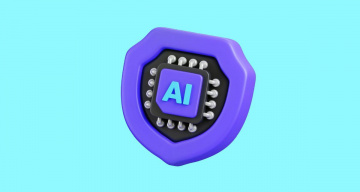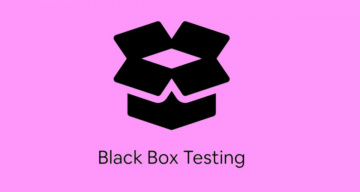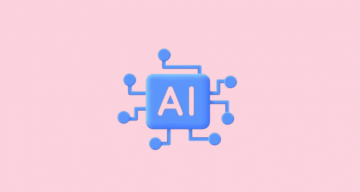The software landscape is constantly evolving, with businesses needing to update apps to meet the ever-rising demand for quality.
Each update brings a potential for disruption, raising the question:
How can we guarantee the app’s key features continue to function as intended?
Here’s where smoke testing shines, imagine releasing an update only to find the app crashes on launch. Smoke testing helps prevent these nightmares. Without it, software engineers risk overlooking critical defects that snowball into bigger problems, leading to costly delays and a compromised user experience. Integrating smoke testing becomes a cornerstone for safeguarding the quality expected from modern applications. Let’s discover more information below ⬇️
What is Smoke Testing?
Smoke testing checks essential functionalities, identifying critical issues that could cause major roadblocks in the testing process.
Smoke testing, also known as confidence testing or verification testing serves as a software testing method employed at the beginning of the software development process, offering a rapid means to assess the functionality of key features. By executing a tailored set of test cases aimed at crucial functionalities, smoke testing ensures early detection of significant issues, preventing potential delays.

Smoke testing’s role extends beyond ensuring stability for subsequent rigorous software testing, as it also safeguards against critical issues becoming entrenched in the software, thereby saving valuable time and resources.
Smoke testing vs. Sanity testing: Which One Do You Need?
These types of testing are both early checks for software but with different goals.
- Sanity testing – a form of targeted regression testing conducted following software updates or minor adjustments, concentrates on essential sections to validate core functionality. With sanity tests, teams delve deeper and may cover a wider array of features, aiming to ensure no significant issues arise after bug fixes.
- Smoke testing – assesses critical functionalities and components of a software version following notable alterations. Its primary objective is the prompt identification of any critical flaws. These assessments concentrate on fundamental features – their failure indicates a vital issue demanding resolution before comprehensive testing.
A table to summarize the key differences between smoke and sanity testing:
| Smoke Testing | Sanity Testing | |
| Purpose | Verify core functionalities and stability. | Check if recent features function as expected. |
| Scope | Broad areas of functionality. | Specific areas affected by code changes. |
| Timing | Early in the development cycle or after a new build. | After codebase changes. |
| Focus | Basic functionality and critical defects. | Correctness of recent modifications or fixes. |
| Performed by | By both testers and developers. | By testers. |
| Execution | By testers. | Manual testing and/or automated testing. |
To sum up, both types are used to catch bugs early. While smoke testing and sanity testing share similarities in terms of quick assessments and early defect detection, they serve different purposes and target different aspects of the software.
Smoke testing focuses on overall system stability, while sanity testing verifies specific changes or fixes.
If applied strategically, you can detect anomalies early and ultimately deliver a smooth and functional app for your users.
😃 Remember, happy users are the ultimate goal, and smoke and sanity testing help you achieve that.
The Purpose of Smoke Testing
Let’s discover why teams need to carry out smoke testing:
- Early Issue Discovery. It allows teams to quickly identify major issues or defects early in the software testing cycle, before investing time and resources in more comprehensive testing.
- Basic Check-Up. It allows teams to check basic functionality before proceeding with more in-depth testing and facing more rigorous testing procedures.
- Test Suite Validation. It double-checks everything – software, test environment, and test suite – before complex testing begins.
- Preventing Problems. It mitigates the risk by catching critical problems before they reach users and cause crashes, data loss, etc.
- Smart Investment. It acts at the beginning to catch major issues early to prevent wasted time and money on further testing a faulty build.
- Confidence in the Software Build. It grants that tests meet a baseline level of quality and stability and shows developers, testers, and project managers they are ready for advanced testing.
Smoke Testing: Key Characteristics Explained
Here are the key characteristics of smoke testing:
- Short & Focused Tests. They offer quick checks for core features, ensuring stability before functional testing.
- Rapid Execution. Designed to run fast, smoke tests provide prompt feedback on the software’s readiness for the next testing phase.
- Repeatable and Automated smoke tests. Scripts or tools automate smoke tests for consistent execution at key points (builds, code commits, deployments).
- Broad Coverage. While individual tests are narrow, the overall suite covers critical components and functionalities (UI, data processing, integrations, core logic).
- Pass/Fail Criteria. Smoke tests have a clear pass or fail outcome. Any failure indicates a critical issue needing attention before other testing types.
- Prioritized & Maintained. Tests prioritize critical features and are regularly reviewed or updated to stay relevant.
- Independent. Smoke tests prioritize basic functionality, bypassing detailed requirements documents.
Types of Smoke Testing
Here’s a breakdown of testing types based on execution methods – manual, automated, and hybrid. Let’s take a closer look below:
| Description | Advantages | Disadvantages | |
| Manual Smoke Testing | Testers manually run tests through the software’s UI or command line. |
|
|
| Automated Smoke Testing | Smoke tests are automated using scripts or testing tools. |
|
|
| Hybrid Testing | Combines both manual and automated testing. |
|
|
In addition to that, smoke testing can be categorized based on how the test cases are conducted:
- Formal Smoke Testing. This type involves a more structured approach, typically led by the QA team or a designated test lead. They design and assign test cases to testers, who then execute them and report the results. Formal smoke testing often follows a documented procedure and might involve using specific testing tools.
- Informal Smoke Testing. This is a less formal approach where developers or testers might perform smoke tests ad-hoc as they build or interact with the software. It’s a more casual way to quickly check basic functionality and identify any glaring issues during development.
How to Perform Smoke Testing?
The smoke testing process might not be separate but rather integrated into the final quality assurance (QA) phase by incorporating smoke test cases. Here’s a breakdown of the typical stages involved in the process:
Stage #1: Identifying Critical Functionalities
This initial stage focuses on defining the essential functionalities crucial for the software’s operation. It might involve reviewing product requirements documents, consulting with stakeholders, or analyzing user stories to understand the core features.
Stage #2: Designing Smoke Tests
At this stage, the development team translates those critical functionalities identified in the first stage into specific test cases. Each test case has a unique identifier and a title summarizing the functionality that is going to be tested.
The test case details the steps involved in executing the test (e.g., entering login credentials, navigating to specific sections) and the expected results if everything works correctly (e.g., successful login, item added to cart).
Stage #3: Execution
The designed smoke tests are carried out against the deployed build, typically on a dedicated testing server separate from the production environment. A testing tool might be used to access the software build and execute the smoke test cases. QA teams document the actual smoke test results obtained while running the tests (e.g., successful login, error message displayed).
Stage #4: Evaluation
This final stage involves analyzing the outcome of the smoke tests. Testers compare the documented Actual Results with the Expected Results defined in the test cases.
- ✅ Pass: If all tests meet the Expected Results, this means that the build has met the minimum level of quality and stability required for comprehensive testing.
- 🔴 Fail: If any smoke test fails (Actual Results differ from Expected Results), this indicates the presence of critical defects or issues that need to be addressed. In this case, the build is sent back for fixing, and the development team works on resolving the identified issues.
Below, you can find a representation of the smoke testing process:
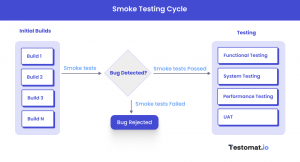
The cycle starts with multiple initial builds (Build 1, Build 2, Build 3, Build N) created during the development process. Each of these builds goes through a smoke test to check the critical functionality of the software.
After the smoke test is performed, there is a decision point: “Bug Detected?”. If no bugs are detected, the build passes the smoke test, and it moves on to the “Testing” phase, which includes various types of testing:
- Functional Testing
- System Testing
- Performance Testing
- User Acceptance Testing (UAT)
However, if the smoke test fails and a bug is detected, the build is rejected, and it needs to go back to the development team for investigation and resolution of the issue. As you see, the cycle of automated smoke testing highlights the iterative nature, where failures lead to investigation and troubleshooting before proceeding with the next testing phase.
When do we do smoke testing?
Smoke testing plays a vital role throughout the Software Development Life Cycle (SDLC). Here are the common scenarios when smoke testing is conducted:
| Scenario | Description | Purpose |
| After a new build is ready. | A new software build or version is compiled | Verify core functionality and identify critical defects before further testing. |
| After a software update or patch. | A software update or patch is released. | Check whether the update doesn’t introduce major issues and whether critical functionalities remain functional. |
| After a system migration or configuration change. | Software is migrated to a new environment, platform, or infrastructure. | Verify software functions correctly in the new environment and no critical issues arise from the migration. |
| Before and after major code changes or refactoring. | Significant code changes, refactoring, or architectural modifications occur. | Ensure core functionality remains intact and no regressions are introduced after code changes. |
| As part of a CI\CD pipeline. | Used in agile development methodologies. | Automatically identify critical issues after each code commit or build before further testing or deployment. |
| During regression testing cycles. | Performed before executing the full regression test suite. | Act as a preliminary check to ensure software stability before comprehensive testing. |
Smoke Test in Action: Real-World Examples for Your Software Product
Here, we are going to illustrate smoke testing with practical examples of test cases familiar to most users. Everyone goes banking online! It demonstrates how smoke testing identifies critical issues early on, saving time and frustration for every user involved.
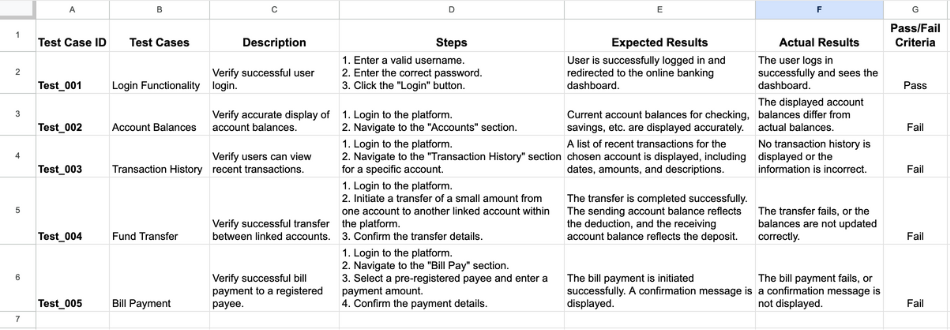
Benefits of Smoke Testing
Successfully passing smoke tests instills confidence that the software build has met a baseline level of quality and stability, offering assurance to stakeholders—such as developers, testers, and project managers—that it’s ready for rigorous testing and evaluation. Additionally, smoke testing brings several other benefits:
- Early Issue Prevention. By catching major defects early on, smoke testing prevents them from cascading into complex problems later in development. This saves time and resources that would be spent on fixing issues buried deep in the codebase.
- Reduced Development Costs. Smoke testing saves significant costs by helping to identify critical problems early and avoid the need for extensive debugging and rework in later stages.
- Boosted Release Readiness. A robust smoke testing process instills confidence in development teams. They can be assured that basic functionalities are working as expected before release reducing the risk of last-minute surprises.
- Reduced Integration Complexity. Smoke testing helps mitigate risks associated with integrations in CI/CD pipelines. By testing each new build with smoke tests, you make sure that all components integrate smoothly and no critical issues arise when adding new functionalities. This leads to a more stable and reliable overall integration process.
- Chance to Leverage Automation. Smoke testing benefits greatly from automation. Automating tests saves time and resources by replacing repetitive manual tasks with faster, more consistent AI-powered execution. This allows for more frequent testing cycles, catching issues earlier and reducing the risk of human error.
- Increased Team Alignment. Smoke testing improves collaboration between development, testing, and other teams. By working together to identify and address critical issues early, all teams see quality as a collective goal and deliver high-quality software.
Best Practices for Smoke Testing
Follow these practices for organizing and running smoke testing for smoother flow:
- Automate Where Possible. Automating smoke tests at various points in the development cycle, such as after a build, code commit, or deployment, using tools like Selenium or Cypress can streamline the testing process and drive rapid and consistent execution.
- Keep Tests Focused. Try to avoid including complex test scenarios and focus on critical functionalities only, keeping them concise to accelerate the testing process.
- Regular Execution. Run smoke tests regularly, preferably after each build or deployment, to catch issues early and maintain the integrity of the application.
- Document Results Thoroughly. Document the results of smoke tests, including any failures or anomalies detected. Clear reporting helps stakeholders understand the software’s stability and make informed decisions about proceeding with other types of testing (acceptance testing, functional testing, regression testing, system testing, integration testing, etc.) or facilitating troubleshooting.
- Integrate Smoke Testing into the CI\CD Pipeline. Integrating smoke testing into the CI\CD pipeline allows you to run automated smoke tests after each code commit or build, providing immediate feedback on the software’s stability.
Smoke testing in test management implementation
In the test management system testomat.io, the functionality to handle smoke tests effectively is implemented. Firstly, we present how it works in general.
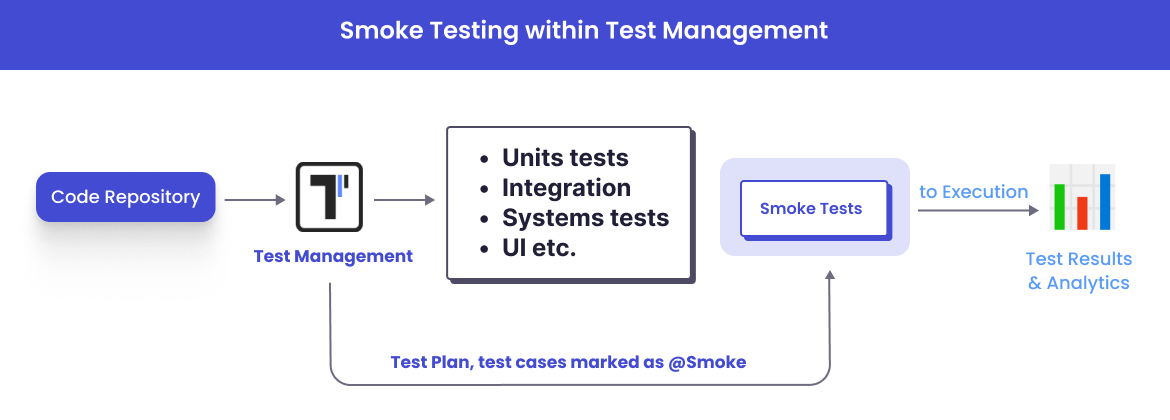
You have the option to organize smoke tests by grouping them using tags or label features. By assigning tests to this category, you can generate separate reports for those tests. Conversely, when running tests alongside other test cases, you can effortlessly analyze smoke test statistics using our Analytics Dashboard, especially the Tag Statistic metric. Also, you are free to do one with filtering of Search Analytics across different projects.
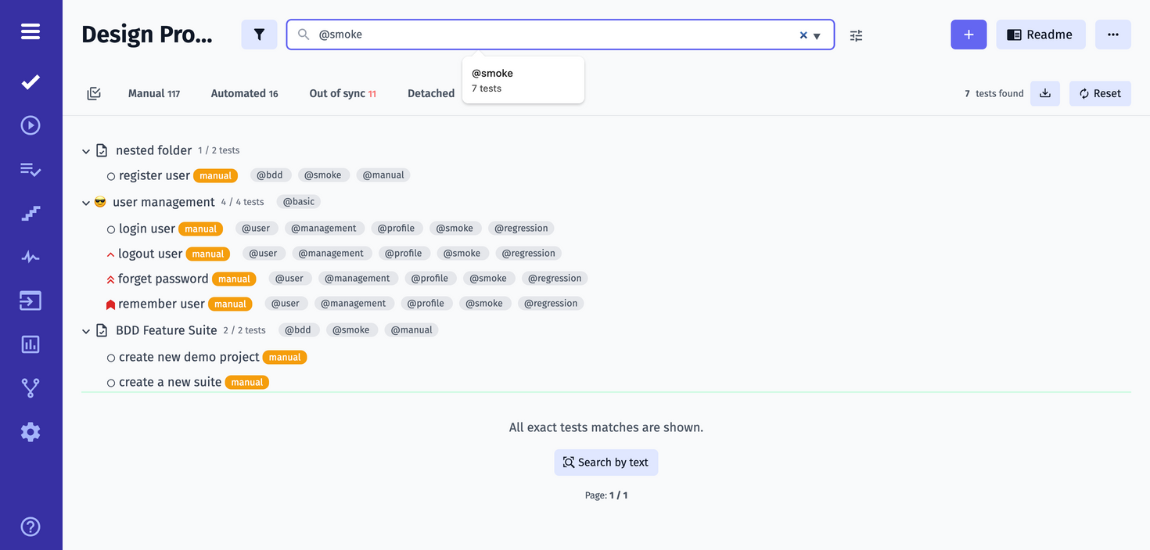
Ready to Ship High-Quality Software with Automated Smoke Tests?
As businesses strive to deliver high-quality applications in a dynamic and competitive landscape, integrating smoke testing into the development processes becomes a necessity. By identifying bugs and any issues early on, smoke testing helps not only mitigate risks and reduce development costs but also accelerates time-to-market.
Furthermore, utilizing smoke testing allows development teams to navigate the complexities of modern software development with agility and assurance that ultimately leads to better outcomes for both businesses and end-users.
Frequently asked questions
What is Smoke testing?

Smoke testing is a preliminary testing process to check if the basic functionalities of a software application are working correctly. It’s like a quick health check to ensure that major essential features are working properly before more detailed testing or release.
When is smoke testing done?

Smoke testing is done typically before more rigorous testing begins or after a new build. It is conducted to verify that the critical functionalities are working as expected and that the build is stable enough for further testing.
What is smoke and sanity testing?

Smoke Testing is a quick check to ensure the core functionality are working before deeper testing. Sanity Testing is a focused check to confirm that some specific changes or fixes in the software working as expected.
